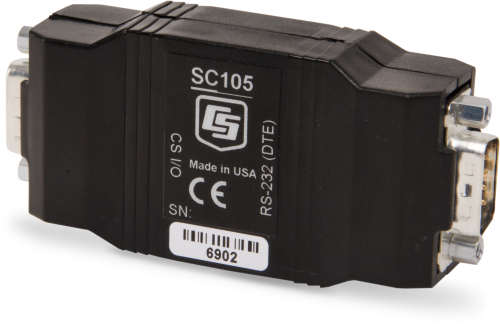






Resumen
El interface SC105 permite comunicar un datalogger Campbell Scientific con un dispositivo RS-232 DCE. Los dispositivos más habituales son modems de telefonía móvil, radiomodems de terceros, u modems de terceros. El SC105 es compatible con cualquiera de nuestros dataloggers y que disponga de puerto CS I/O.
Leer másVentajas y características
- Soporta comunicaciones entre un datalogger y un dispositivoRS-232 DCE
- Comunica a velocidades de hasta 115.2 kbps
- Proporciona buffering interno para asegurar que no se pierdan datos durante la transmisión
- El datalogger puede funcionar a una velocidad distinta de la del dispositivo DCE
- No requiere alimentación externa
- Compatible con la mayoría de dataloggers Campbell Scientific
- Ayuda a proteger los componentes de daños eléctricos
- Incluye cables conexión
Imágenes

Descripción detallada
El SC105 dispone de buffer interno que guarda datos temporalmente. Esto permite al datalogger y al dispositivo DCE, funcionar a distintas velocidades, almacenando los datos recibidos del dispositivo más rápido hasta que el dispositivo más lento está listo para recibirlos. El buffer asegura también que no se pierdan datos durante la transmisión.
Productos similares
Preguntas frecuentes
Número de FAQs relacionadas con SC105: 9
Expandir todoDesplegar todo
-
The SC105 uses the RS-232 standard, which is not compatible with multidrop communications (more than two devices on the same RS-232 bus). There are some third-party devices on the market that allow multiple devices to communicate over the same RS-232 link.
-
Depending on what equipment is being used, a special interface may be required to attach a specific device to the datalogger’s CS I/O port. In general, devices with a CS I/O port can be attached directly to the datalogger’s CS I/O port. Devices with an RS-232 port require a special interface, such as the SC932A or SC105, to connect to the datalogger’s CS I/O port.
-
Both the computer’s serial port and the SC105’s RS-232 port are configured as data terminal equipment (DTE) devices. Because both components are DTE, a null modem cable is needed between them.
-
The SC105 needs to be connected to the datalogger’s CS I/O port, either directly or with the included SC12 cable. The SC105’s RS-232 port needs to be connected to the PC’s serial port using the included null modem cable.
-
Yes, if the PDA has an RS-232 port.
-
Using an SC105 with a RavenXTV or RavenXTG cellular modem allows for the two devices to communicate at differing baud rates. It also allows for other devices, such as an RF401 radio or CR1000KD handheld display, to simultaneously be connected to the datalogger’s CS I/O port.
-
The SC932A only is compatible with modem-enabled (ME) two-way communication between a datalogger and a modem. In contrast, the SC105 is compatible with both ME and Synchronous Device for Communication (SDC) communications, as well as having the ability to internally buffer data.
-
Most third-party modems require a null modem cable, SC105, SC110 cable, or SC932A to interface with a datalogger. Many modems manufactured by Campbell Scientific can connect directly to a datalogger’s CS I/O port using an SC12 or serial cable.
-
An RS-232 device cannot be directly connected to the CS I/O port of the data logger. A peripheral, such as an SC932A or SC105, is required.
Compatibilidad
Nota: lo siguiente muestra información de compatibilidad notable. No es una lista de todos los productos compatibles.
Dataloggers
| Producto | Compatible | Nota |
|---|---|---|
| 21X (retired) | The 21X does not support direct output to a printer; use an SC932 for this purpose. | |
| CR10 (retired) | ||
| CR1000 (retired) | ||
| CR10X (retired) | ||
| CR200X (retired) | ||
| CR216X (retired) | ||
| CR23X (retired) | ||
| CR3000 (retired) | ||
| CR500 (retired) | ||
| CR5000 (retired) | ||
| CR510 (retired) | ||
| CR6 | ||
| CR800 (retired) | ||
| CR850 (retired) | ||
| CR9000 (retired) | ||
| CR9000X (retired) |
Información de compatibilidad adicional
Conexiones cable y elementos fijación
Se entregan tres cables con el SC105 (13657 Null Modem Cable, SC12 CS I/O Data Cable, y 10873 Serial Data Cable). El cable 13657 sirve para programar el SC105 mediante ordenador. El SC12 conecta el SC105 al datalogger, y el cable 10873 conecta el SC105 al puerto RS-232 DCE del dispositivo. El cable SC12R-6 (que se puede adquirir por separado) se puede utilizar en lugar del SC12 si se requiere más distancia.
El kit de montaje 16987 permite fijar el SC105 en la placa de montaje de nuestros armarios intemperie.
Consideraciones Datalogger
Note: When using an SC105 with OS version 4 or newer with a mixed-array datalogger, the datalogger operating system should be updated to the latest released version
Especificaciones
| Baud Rates Supported | 1200, 9600, 19200, 38400, 57600, 115200 bps |
| RS-232 Parity Supported | Even, odd, none |
| RS-232 Data Bits Supported | 7, 8 |
| CS I/O Port Modes | CSDC, SDC, ME, Addressed Print Device for P96 output |
| Power Requirements | Data logger’s 5 V supply |
| Current Drain |
|
| Operating Temperature Range |
|
| Operating Relative Humidity | up to 95% (non-condensing) |
| Dimensions | 2.3 x 4.3 x 9.2 cm (0.9 x 1.7 x 3.6 in.) |
| Weight | 45.4 g (1.6 oz) |
Documentos
Folletos producto
Conformidad
Descargas
SC105 OS v.04 (573 KB) 28-08-2007
Current SC105 firmware. Requires the Device Configuration Utility and a 9-pin socket (female) to socket (female) NULL modem cable.
Device Configuration Utility v.2.32.01 (47.7 MB) 15-04-2025
A software utility used to download operating systems and set up Campbell Scientific hardware. Also will update PakBus Graph and the Network Planner if they have been installed previously by another Campbell Scientific software package.
Supported Operating Systems:
Windows 11 or 10 (Both 32 and 64 bit)
Casos de aplicación
Korea Expressway Corporation (KEC) was established in 1969 to construct and manage expressways throughout South......leer más

